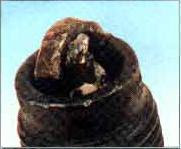
Symptoms: Brown
to grayish-tan color and slight electrode wear. Correct heat range for engine and
operation conditions
Recommendation: When
new spark plugs are installed, replace with plugs of the same heat range.
to grayish-tan color and slight electrode wear. Correct heat range for engine and
operation conditions
Recommendation: When
new spark plugs are installed, replace with plugs of the same heat range.
OVER HEATED
 Symptoms: Blistered, white
Symptoms: Blistered, whiteinsulator, eroded electrode and absence of deposits. Results in shortened plug life
Recommendation:
Check for the correct plug heat range, over advanced ignition timing, lean
fuel mixture, intake manifold vacuum leaks, sticking valves and insufficient engine
cooling.
WORN
Rounded electrodes with a small amount of deposits on the firing end. Normal
color. Causes hard starting in damp or cold weather and poor fuel economy.
Recommendation:
Plugs have been left in the engine tool long. Replace with new plugs of the
same heat range. Follow the recommended maintenance schedule.
CARBON DEPOSITS
 Symptoms: Dry
Symptoms: Drysooty deposits indicate a rich mixture or weak ignition. Causes misfiring, hard starting
and hesitation
Recommendation:
Make sure the plug has the correct heat range. Check for a clogged air
filter or problem in the fuel system or engine management system. Also check for ignition
system problems
PRE IGNITION
 Symptoms:
Symptoms:Melted electrodes. Insulators are white but may be dirty due to misfiring or
flying debris in the combustion chamber. Can lead to engine damage.
Recommendation:
Check for the correct plug heat range, over advanced ignition timing, lean
fuel mixture, insuficient engine cooling and lack of lubrication.
ASH DEPOSIT
 Symptoms: Light
Symptoms: Lightbrown deposits encrusted on the side or center electrodes or both. Derived from all and/or
fuel additives. Excessive amounts may mask the spark, causing misfiring and hesitation
during acceleration.
Recommendation: If excessive deposits accumulate over a short time or
low mileage, install new valve guide seals to prevent seepage of oil into the combustion
chambers. Also try changing gasoline brands.
HIGH SPEED GLAZING
 Symptoms:
Symptoms:Insulator has yellowish, glazed appearance. Indicates that combustion
chamber temperatures have risen suddenly during hard acceleration. Normal deposits melt to
form a conductive coating. Causes misfiring at high speeds.
Recommendation: Install new plugs. Confider using a colder plug if
driving habits warrant
OIL DEPOSITS
 Symptoms: Oily
Symptoms: Oilycoating caused by poor oil control. Oil is leaking past worn valve guides or piston rings
into the combustion chamber. Causes hard starting, misfiring and hesitation.
Recommendation:
Correct the mechanical condition with necessary repairs and install new
plugs.
GAP BRIDGING
 Symptoms:
Symptoms:Combustion deposits lodge between the electrodes. Heavy deposits accumulate
and bridge the electrode gap. The plug ceases to fire, resulting in a dead cylinder.
Recommendation:
Locate the faulty plug and remove the deposits from between the electrodes.
DETONATION
 Symptoms:
Symptoms:Insulators may be cracked or chipped. Improper gap setting techniques can
also result in a fractured insulator tip. Can lead to piston damage.
Recommendation:
Make sure the fuel anti-knock values meet engine requirements. Use care when
setting the gaps on new plugs. Avoid lugging the engine
MECHANICAL DAMAGE
 Symptoms: May
Symptoms: Maybe caused by a foreign object in the combustion chamber or the piston striking an
incorrect reach (too long) plug.
Causes a dead cylinder and could result in piston damage.
Recommendation:
Repair the mechanical damage. Remove the foreign object from the engine
and/or install the correct reach plug.










No comments:
Post a Comment